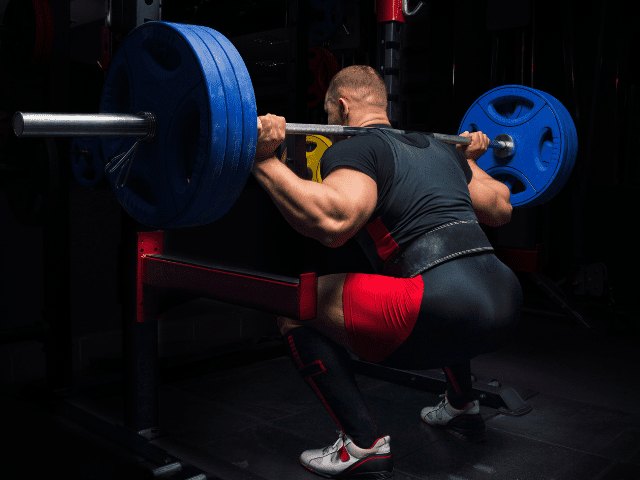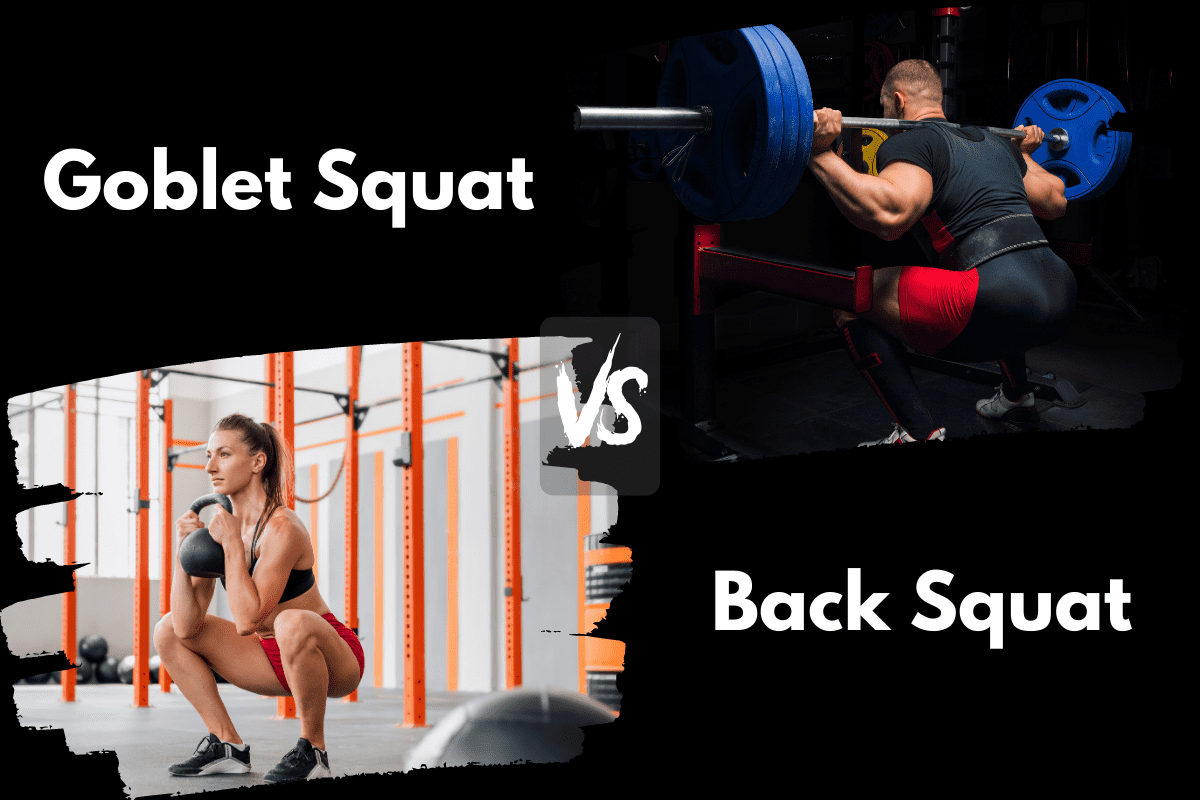Goblet Squat vs Back Squat (Which is Better For Strength?)
The Goblet Squat and the Back Squat are two exercises that are commonly used to build strength and muscle in the legs and glutes. While they are both squatting exercises with almost identical movement patterns, they have some key differences that make them very different.
Knowing the differences between the two exercises is extremely beneficial so that you can know how and when to incorporate each exercise into your training program.
In this guide, I’m going to go over how to properly perform both exercises, including coaching tips and the benefits of both movements. Then, I’ll compare the two squats side-by-side so you can better understand how to utilize them based on your training goals.
Goblet Squat
Equipment Needed
- Kettlebell (Dumbbell can be used as well)
Step-by-Step Instructions
- Grab a kettlebell and hold it at chest level, cradling the bottom of the bell in both hands*.
- Stand with feet shoulder-width apart, chest out, lats engaged, eyes straight ahead.
- Before descending into the squat, fill the abdomen full of air and brace the core.
- Start the start by pushing the hips back first.
- Bend the hips and knees, keeping the chest up and knees pushed out until the thighs become parallel to the floor.
- Now push the feet through the floor and drive yourself back up to the starting position.
- Repeat for the designated number of reps.
Coaching Points
*It’s also acceptable to hold the kettlebell on each side of the handle (as shown in the image above).
As with any squat, the most important aspect of the movement is to keep the core braced to protect the spine and to maintain proper posture – chest out and lats engaged.
Make sure to use full range of motion, even when doing Goblet Squats during high-tempo circuits.
Looking for Goblet Squat alternatives? Here are some of my favorite alternatives to Goblet Squats.
Benefits of Goblet Squats
Goblet Squats have several benefits, including:
Improved Core and Upper Body Strength
Holding a weight in front of the chest during a goblet squat requires the use of the core muscles to maintain proper posture and balance. Holding a weight in front of the chest also engages and works the upper back, shoulders and arms.
Improved Squat Technique
The Goblet Squat is a simpler squatting movement that allows people (especially younger lifters and/or beginners) to focus on proper form and technique, which can lead to better form and technique when performing more advanced squatting exercises.
Versatility
Goblet Squats can be performed with a variety of equipment, including dumbbells, kettlebells, and even sandbags, making them a versatile exercise that can be done at home or in the gym.
Beginner-Friendly
Goblet squats are a relatively easy exercise to learn and execute, which makes them a great option for beginners and young athletes with limited experience with weightlifting.
Back Squat

Equipment Needed
- Squat Rack
- Barbell
Setup
In setting up for the Back Squat, athletes choose between the high bar and low bar position. (Personally, I teach a high bar position with athletes)
Regardless of bar placement, the athlete should actively pull their shoulders together and back in order to both create a shelf for the barbell to rest on. This is also to generate as much upper body tension as possible in order to maintain a consistent torso position for the duration of the lift.
A good cue here is to have the athlete pin their elbows down by their sides, similar to the bottom position of a Lat pulldown, before placing the bar on their shoulders.
Generally speaking, the athlete should place their hands as close together as comfortably possible, which helps maintain the aforementioned upper body tightness and shelf for the barbell to rest on.
Certain athletes will experience pain in either their shoulders, elbows, or wrists when setting up for the back squat. Most athletes can work through these issues and squat comfortably by adopting different combinations of the following variables: bar position (high bar and low bar), hand width (wider/more narrow), or adopting a grip with their thumbs over or under the bar.
After setting up properly, the athlete un-racks the bar and walks it out of the uprights, takes a big breath in, braces their core, and initiates the eccentric portion of their squat.
Eccentric
While maintaining a tight brace in their core and tension in their upper back (as mentioned in the setup paragraph), the athlete initiates downward motion of the bar via simultaneous hip and knee flexion until the crease of their hip goes below the knee.
The especially important part of the range of motion is taking the muscle to its full eccentric length, demonstrating that athletes further benefit by taking their squats to the deepest depth that their mobility allows. Once the athlete reaches their lowest position in the squat, they transition from the eccentric to concentric portion.
Concentric
The concentric portion of the squat involves the athlete rising out of the hole via a combination of knee and hip extension.
In rising out of the hole, athletes commonly experience sticking points either in the hole or when they are just above parallel. These can vary based on each athlete’s relative strengths and weaknesses, or some technical errors to be addressed later. Once the athlete completes the rep, they exhale, and either initiate the next rep or re-rack the bar.
Re-rack
Upon completing the last rep of their set, the athlete should maintain their brace, and walk the bar back into the uprights.
Coaching Points
The heels coming up during the squat is a common technical error at the bottom of the squat, where the bar comes forward of the athlete’s center of mass and forces them to lift their heels off the ground.
Two common fixes for this are to have the athlete sit back into the squat to keep their balance over their mid-foot, and to have the athlete actively pull the bar down into their back using their lats.
Athletes who are still having trouble due to poor ankle dorsiflexion, long femur length relative to their height, or a combination of both, can use a device to elevate their feet such as weightlifting squat shoes, an angled plate, or 2.5lb weights to help address the issue.
Benefits
The Back Squat helps improve overall athletic performance, as it trains the muscles used in activities such as running, jumping, and lifting. Other potential benefits of the Back Squat include:
- Increased muscle size and strength: The Back Squat targets large muscle groups in the lower body, which can lead to increased muscle size and strength over time.
- Improved mobility and flexibility: Squatting requires a full range of motion in the hips, knees, and ankles, which can help improve mobility and flexibility in these joints.
- Improved bone density: Resistance training, such as the Back Squat, has been shown to increase bone density, which can help reduce the risk of osteoporosis and other bone-related conditions.
- Enhanced cardiovascular fitness: The Back Squat can be performed with high reps and moderate to high intensity, which can provide a cardiovascular challenge and improve overall fitness.
It’s important to note that the benefits of the Back Squat can vary depending on individual factors, such as training experience and strength.
Goblet Squats vs Back Squats: Which is Better?
Now, let’s take a side-by-side look at both squats to see if one or the better than the other for some common lifting goals.
Better For Developing Size and Strength: Back Squat
To be honest, this isn’t even close. Goblet Squats have their benefits (I’ll get to those in a second), but when it comes to building strength and muscle mass Back Squats are the superior exercise.
In my opinion, Back Squats are the single best exercise for strength development. Back Squats are a near total-body movement that involves every lower-body muscle group. Because it’s axial loaded (on the back of the shoulders) with a barbell it also gives the lifter the ability to use heavy loads.
This is why Back Squat is an integral part of training programs for athletes, powerlifters, weightlifters and even bodybuilders.
Goblet Squats will be limited by the amount of weight you’re able to hold and/or available equipment. The heaviest weight many of us have access to is a 100-pound dumbbell (and that is probably still more than what is in many home gyms).
Both of those factors will limit the amount of strength you’re going to be able to build.
Better For Beginners: Goblet Squats
Goblet Squats’ biggest benefit is the simplicity of its technique. Holding a weight in front of the body is a great way to first introduce young athletes and beginners to squatting with resistance.
Goblet Squats can teach lifters how to brace their core and maintain proper body positions more safely and with a lower risk of injury than other variations. Once lifters become proficient with Goblet Squats they can then move on to more advanced squat movements.
This is not to say Back Squats are not beneficial for beginners because they 1000% can be. However, learning proper technique has to be achieved first and then lifters can slowly start to increase in weight used.
Final Thoughts
I’ve just spent the last section of this article comparing which is better – Back Squats vs Goblet Squats. I love Back Squats and believe it’s one of the most beneficial exercises an athlete (and non-athletes) can do.
Goblet Squats also have their place within a training program as well. They’re great for beginners to start to learn proper squat technique and they can also be a great option to be included in circuit training.
The key is understanding what your goals are and then choosing the squat variation that helps get you there.

